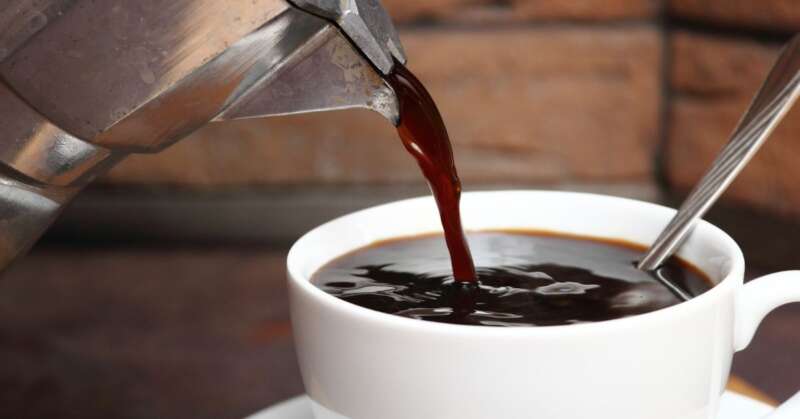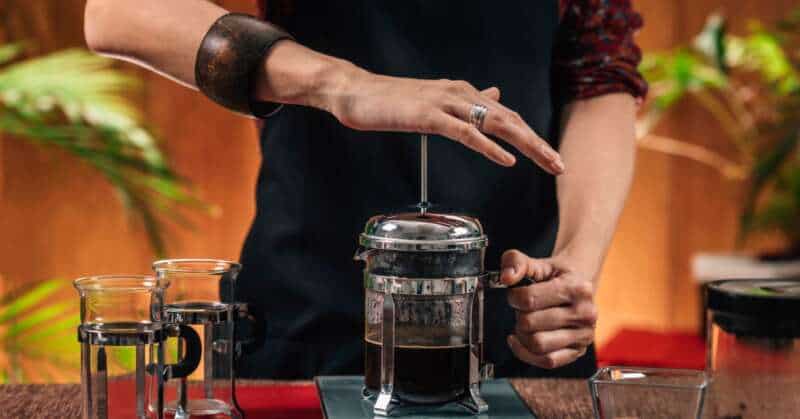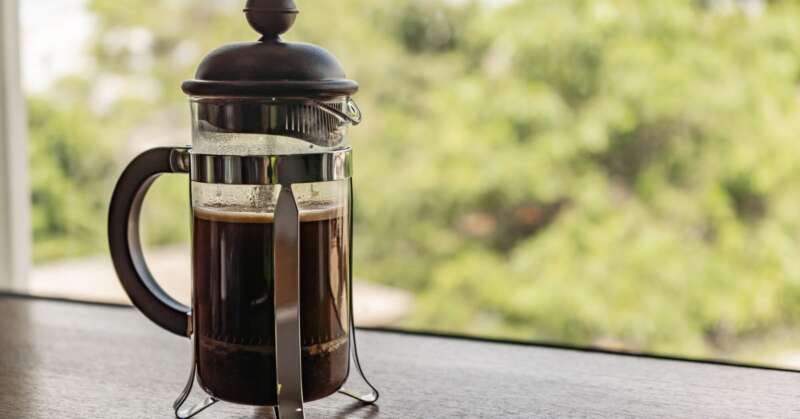When it comes to making coffee, everyone has their favorite methods. The French press and the Moka pot are two of the most popular coffee makers.
Both make delicious coffee, but they’re also very different. Ask one hundred coffee enthusiasts which method is best, and they all won’t agree.
The truth is that it boils down to individual taste. So, to help you decide which is best, we’ll tell you about the two unique brewing methods so you can decide.
French Press vs Moka Pot: A Quick Summary of The Main Differences
| French Press | Moka Pot | |
|---|---|---|
| Brewing method | steeping | pressure percolator |
| Heat source | hot water | stove |
| Ease of use | easy | medium |
| Best roast | all | medium/medium-dark/dark |
| Grind size | fine/medium-fine | coarse |
| Coffee style | full-bodied | sharp and rich |
| Sizes | 8 oz – 51 oz | 1-12 cups |
| Price range | $10 – $100 | $20 – $70 |
| Brewing time | 5 to 10 minutes | 5 to 7 minutes |
As you can see, the main difference between the two is their brewing methods. Let’s look into each and how they work so, you can decide which suits your tastes.
What Is a Moka Pot?
The Moka pot was first invented in the 1930s by an Italian engineer, Alfonso Bialetti, to make coffee quickly and efficiently. Back then, making coffee was otherwise laborious, and this invention quickened the process.
This stovetop coffee maker is made up of three separate parts:
- The upper chamber collects brewed coffee.
- The middle basket section holds the coffee grounds.
- And the lower chamber holds the water.
When the water in the lower chamber is heated by the stove below, steam pressure forces it up through the ground coffee and out into the upper chamber.
Despite being around for nine decades, this is still a much-loved way of making coffee and is still the favored way amongst Italians. This is why you might hear it called an Italian espresso.

How Do Moka Pots Work?
These coffee makers work like coffee percolators, except that they use pressure.
As the water heats, the increase in pressure means the water is forced up the spout, through the ground coffee, and into the upper chamber.
Finally, when all the water has gone through to the top, you’ll hear a gurgling that tells you it’s ready.
If you want to enjoy a rich, espresso-like coffee at home, learning how to use a moka coffee pot can be a game-changer for your morning routine.
As this coffee maker only requires a stove, you can also use it when camping!
As long as you take good care of your stovetop espresso maker, it will last forever.
What Is a French Press Coffee Maker?
French presses are coffee pots that steep ground coffee. They have an attached plunger on the lid, which decants the coffee when it is ready to be poured.
As you might imagine, these were invented in France. But, they were first created by accident in the mid-19th century when a man boiled water over an open fire and added ground coffee.
He noticed the coffee grounds floated and so he purchased a piece of screening made of metal and used a stick to push the grounds to the bottom. And the rest, as they say, is history.
Though the French press was originally French in design, it was first patented by Giulio Moneta and Attilio Calimani, two Italians, in 1929.
You might also hear a French press referred to as a coffee plunger or cafetière.
How Do French Presses Work?
A French press is an easy coffee maker. Ground coffee is added to the pot, hot water is poured over them, and left for several minutes to steep. Once steeped, the plunger within the lid is pushed down slowly to separate the coffee grounds from the liquid.
The result is a rich, full-bodied coffee. This is because the resulting coffee retains the oils and makes it aromatic.
Because the mesh doesn’t remove all of the particles of coffee, you might find some sediment in your drink. But the amount will depend on the quality of the coffee maker.

Key Differences: Moka Pot vs French Press
As we’ve seen from the summary above, there are some key differences between the two coffee makers. Let’s now explore these.
Grind Size
Moka pots need a fine or medium-fine grind, while French press coffee needs coarsely ground coffee. This is due to how the coffee comes into contact with the hot water and for how long.
With a Moka pot, a finer grind size is needed because the water isn’t in contact with the coffee for long, so it needs a larger surface area. With a French press, the water is in contact for longer, so a coarser grind is better. This also means that there is less sediment in the resulting drink too.
Quality of Coffee
Moka pots make strong coffee like an espresso machine. The resulting brew mixes with cream or milk well. However, though it’s excellent at giving you your morning caffeine fix, French press coffee is more full-bodied.
Coffee made in a French press is less overpowering than Moka pot coffee. It also brings about the different flavors and nuances in the beans. Therefore, some argue that the French press wins regarding quality and taste.
Ease of Use
A Moka pot is easy to use and cleans well. However, when it comes to cleaning a French press coffee maker, it’s a little more troublesome. This is because the leftover grounds in a Moka pot are dry and will easily tap into the trash.
However, a French press leaves sludgy grounds, which means it takes more work to deal with.
Brewing Process Control
Regarding the brewing process, it’s much easier to control things with a French press. For example, you can control how much coffee is made, the ratio, the steeping time, etc. With Moka pots, you can’t really control any variables.
Brewing Time
In this respect, both methods are similar. The coffee grounds will steep in a French press for an equivalent amount of time it takes to brew coffee in a Moka pot.
Both methods produce coffee in around 5 minutes. However, as we’ve mentioned above, clearing a French press will take longer.
Portability
Whether you use a stainless steel Moka pot or an aluminum one, it will be robust and rigid enough to take away with you. So whether you go camping or stay in an apartment, you can bring this home comfort with you.
On the other hand, a French press coffee maker is usually made of glass and is quite delicate and fiddly. Though it would be easier to use in places like a hotel room with an electric kettle, you’re likelier to break it in your bag before you get there.
Though a Moka pot won’t break, it can only be used anywhere with a stove or open fire.
Sizes Available
You can find Moka pots in a range of sizes. They range in size from a one-cup espresso maker all the way up to large 12-cup contraptions. For a French press coffee maker, you start at 3 cups and go up to 12.
Materials
Your typical Moka pot will be constructed from aluminum or stainless steel, while a French press is usually made from glass, metal, and plastic. In terms of durability, it’s clear who would win in a Moka pot vs French press drop test.

Price
As far as price goes, you’ll find a Moka pot to be more affordable, especially if you buy a small one. Moka pots are generally considered a coffee-making staple and aren’t particularly fancy. They’re good at brewing coffee for you in the morning but don’t look so great on a shelf.
A French press, however, will cost a little more and is generally considered to be a fancier coffee-making choice. This is because you can experiment with brewing times and ratios to personalize the end result.
Flexibility
A French press can use any coffee beans, and you’ll get delicious coffee every time. Thanks to the steeping extraction method, your French press works well on lighter and darker roasts. This is because the brewing process retains the oils within your drink.
You can also use a French press to make a cold brew, which can’t happen with a Moka pot.
French press coffee can be tweaked and altered until you get a flavor you love.
As for a Moka pot, you need more flexibility. You can, of course, choose the coffee beans you use, but you won’t get a great coffee from a light roast. If you use a lighter roast, your end result will be acidic and thin. French press coffee, on the other hand, is much more of a thick coffee.
This is because Moka pot coffee was designed to be a dark roast, so it will only extract nuances well if you use a lighter roast.
What’s more, you can’t change the extraction process with a Moka pot. The only thing you can do is make sure you heat the water up slowly. So there is lots of guesswork involved compared to a French press.
Moka Pot vs French Press Pros and Cons
There are lots of advantages and disadvantages to each coffee maker. Let’s look at them.
Moka Pot Coffee
Pros
- Moka pots brew coffee quickly and cleanly
- The coffee is strong
- The coffee maker is traditional and elegant
- Clean-up is easier
- It is portable and robust
Cons
- You need a fire or a stovetop
- It’s hard to make coffee for a lot of people
- It takes between four and six minutes
- You can’t use lighter roasts
French Press Coffee
Pros
- The coffee taste is bold and flavorful
- The finished coffee can be tweaked and personalized
- You can make coffee for larger groups
- You can make cold brew
- You can use a light roast
Cons
- You can’t make espresso
- Making a French press brew takes a little longer than a Moka pot
- Cleaning a French press is harder
- It’s more fragile
Moka Pot vs French Press: Which One Wins?
Historically, people have believed French presses to be a part of higher-brow coffee culture. In contrast, a Moka pot coffee brewer belonged to the working class.
Things have changed, however, and these beliefs no longer hold true. Lots of people – especially coffee lovers – have both at home because they recognize the benefits of each coffee brewing method.
If you need to know which option to go for, it really depends on how you like your coffee.
A Moka pot will give you a quick caffeine fix in next to no time, with a much easier cleanup afterward. A French press, however, will produce a delicious brew and a bold coffee.
Also, with a Moka pot, you can’t tweak your end result, and your coffee tastes the same every time. A French press is ideal for those who like experimenting with the brewing process and the type of coffee bean they use.